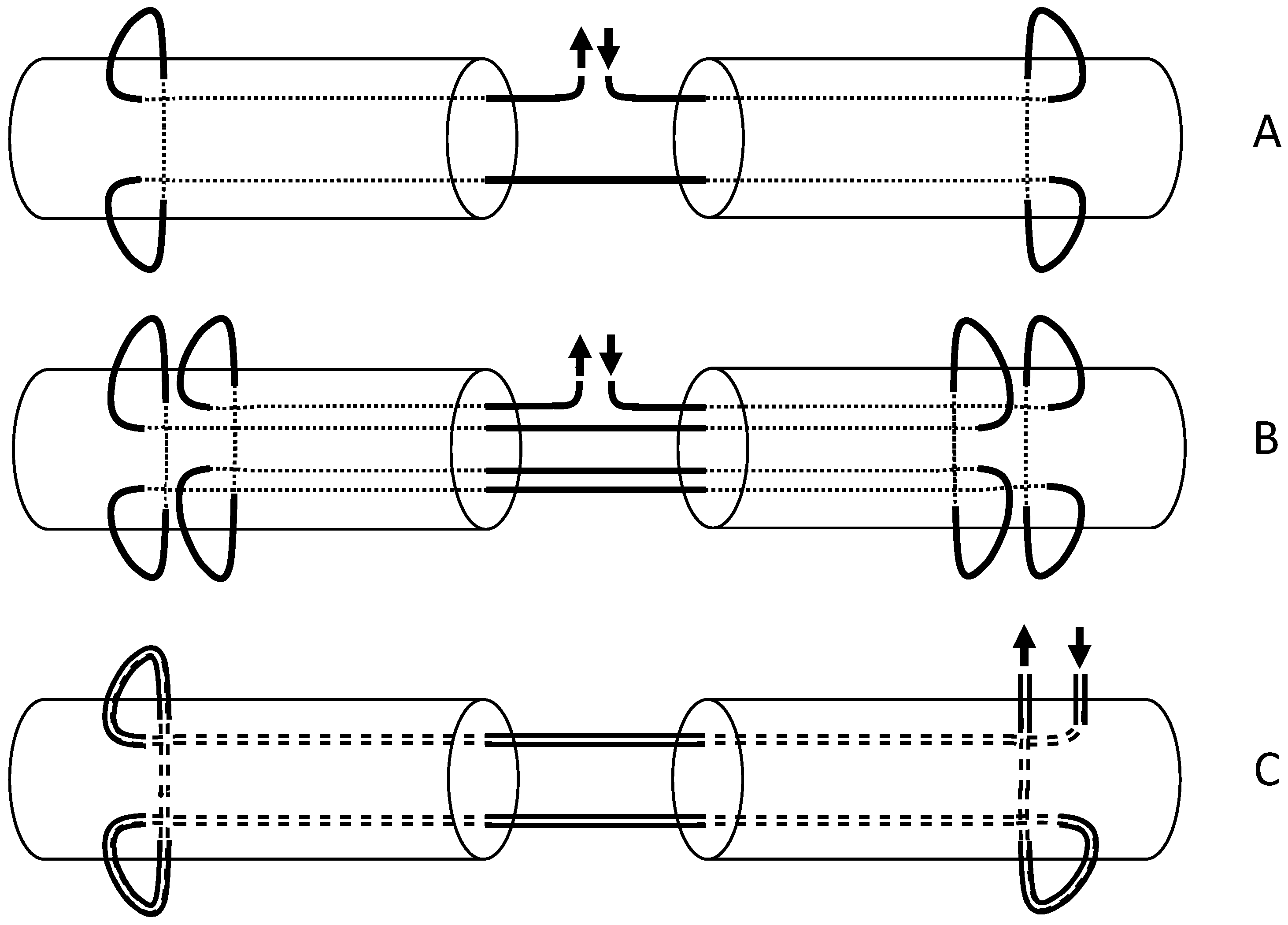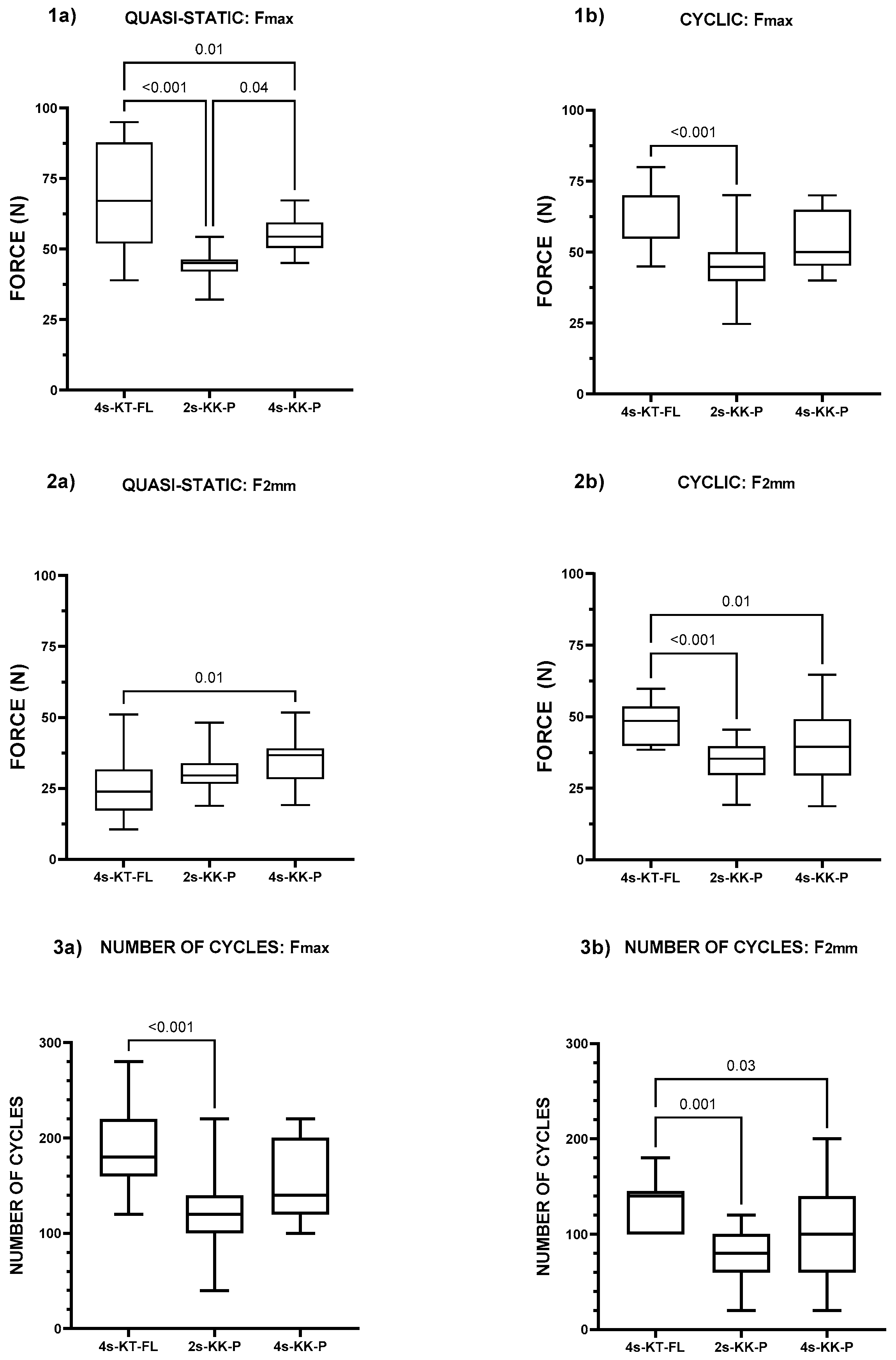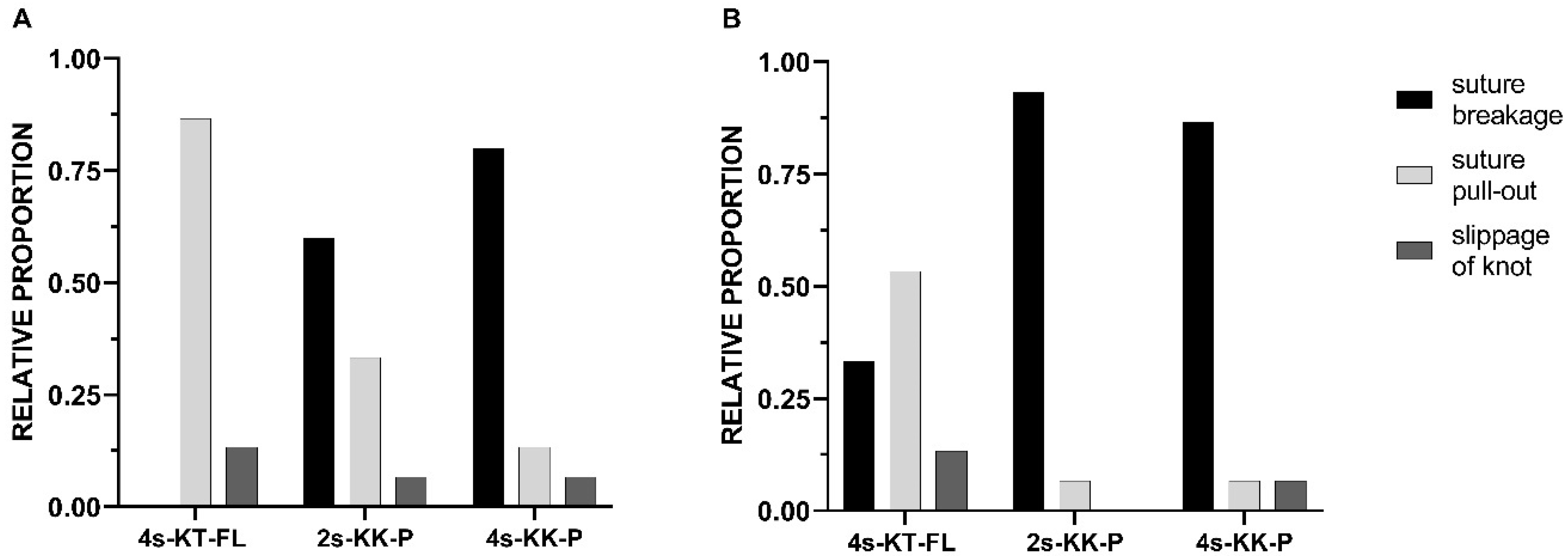Biomechanical Comparison of Three Modified Kessler Techniques for Flexor Tendon Repair: Implications in Surgical Practice and Early Active Mobilization
Abstract
1. Introduction
2. Materials and Methods
2.1. Materials
2.2. Methods
2.2.1. Study Design
2.2.2. Suture Technique for Tendon Repair
2.2.3. Biomechanical Testing
2.2.4. Statistical Analyses
3. Results
3.1. The Four-Strand Kessler–Tsuge FiberLoop® Repair Yields a Higher Maximum Force than the Two- and Four-Strand Kirchmayr–Kessler Repair
3.2. The Four-Strand Kessler–Tsuge Fiberloop® Repair Yields a Higher Force at 2 mm Gap Formation than the Two- and Four-Strand Kirchmayr–Kessler Repair in Cyclic Testing
3.3. The Four-Strand Kessler–Tsuge FiberLoop® Repair Demonstrates a Higher Number of Completed Cycles and a Greater 2 mm Gap Force than the Two- and Four-Strand Kirchmayr–Kessler Repair
3.4. Suture Pull-Out Was the Primary Failure Mode in the Four-Strand Kessler–Tsuge FiberLoop® Repair and Suture Breakage in the Kirchmayr–Kessler Prolene® Repairs
4. Discussion
4.1. Strand Number and the Technique Chosen Have an Effect on the Force at Failure in FDP Repair
4.2. The Kessler–Tsuge Repair Yielded a Higher Force at 2 mm Gap Formation and Differed in Failure Mode Compared to the Kirchmayr–Kessler Repair
4.3. The Cyclic Scenario Well Reflects the Beneficial Findings of the Four-Strand Kessle–-Tsuge Repair
4.4. Limitations
5. Conclusions
Author Contributions
Funding
Institutional Review Board Statement
Informed Consent Statement
Data Availability Statement
Conflicts of Interest
Abbreviations
| EAM | Early active motion |
| FDP | Flexor digitorum profundus |
| 2s-KK-P | Two-strand Kirchmayr–Kessler with Prolene |
| 4s-KK-P | Four-strand Kirchmayr–Kessler with Prolene® |
| 4s-KT-FL | Four-strand Kirchmayr–Tsuge with FiberLoop® |
References
- Khor, W.S.; Langer, M.F.; Wong, R.; Zhou, R.; Peck, F.; Wong, J.K.F. Improving Outcomes in Tendon Repair: A Critical Look at the Evidence for Flexor Tendon Repair and Rehabilitation. Plast. Reconstr. Surg. 2016, 138, 1045e–1058e. [Google Scholar] [CrossRef] [PubMed]
- Renner, C.; Corella, F.; Fischer, N. Biomechanical Evaluation of 4-Strand Flexor Tendon Repair Techniques, Including a Combined Kessler-Tsuge Approach. J. Hand Surg. 2015, 40, 229–235. [Google Scholar] [CrossRef] [PubMed]
- Linnanmäki, L.; Göransson, H.; Havulinna, J.; Karjalainen, T.; Leppänen, O.V. Factors Accounting for Variation in the Biomechanical Properties of Flexor Tendon Repairs. J. Hand Surg. 2018, 43, 1073–1080.e2. [Google Scholar] [CrossRef] [PubMed]
- Tang, J.B. Investigations into Flexor Tendon Repair: A Research Journey over Three Decades. J. Hand Surg. Eur. Vol. 2022, 47, 568–579. [Google Scholar] [CrossRef] [PubMed]
- Zeplin, P.H.; Zahn, R.K.; Meffert, R.H.; Schmidt, K. Biomechanical Evaluation of Flexor Tendon Repair Using Barbed Suture Material: A Comparative Ex Vivo Study. J. Hand Surg. 2011, 36, 446–449. [Google Scholar] [CrossRef] [PubMed]
- Klifto, C.S.; Capo, J.T.; Sapienza, A.; Yang, S.S.; Paksima, N. Flexor Tendon Injuries. J. Am. Acad. Orthop. Surg. 2018, 26, e26–e35. [Google Scholar] [CrossRef] [PubMed]
- Tang, J.B. Recent Evolutions in Flexor Tendon Repairs and Rehabilitation. J. Hand Surg. Eur. Vol. 2018, 43, 469–473. [Google Scholar] [CrossRef] [PubMed]
- Mao, W.F.; Wu, Y.F. Effects of a Q Suture Technique on Resistance to Gap Formation and Tensile Strength of Repaired Tendons: An Ex Vivo Mechanical Study. J. Hand Surg. 2020, 45, 258.e1–258.e7. [Google Scholar] [CrossRef]
- Jordan, M.C.; Boelch, S.; Jansen, H.; Meffert, R.H.; Hoelscher-Doht, S. Does Plastic Suture Deformation Induce Gapping after Tendon Repair? A Biomechanical Comparison of Different Suture Materials. J. Biomech. 2016, 49, 2607–2612. [Google Scholar] [CrossRef]
- Scherman, P.; Haddad, R.; Scougall, P.; Walsh, W.R. Cross-Sectional Area and Strength Differences of Fiberwire, Prolene, and Ticron Sutures. J. Hand Surg. Am. 2010, 35, 780–784. [Google Scholar] [CrossRef]
- De Las Heras, J.; Sanudo, J.R.; Simón de Blas, C.; Krompas, I.; SalaBerri, G.J.; Aragonés, P. The Incidence and Shape of the Digital Pulleys: A Study of 192 Fingers in 48 Cadaveric Hands. J. Hand Surg. Eur. Vol. 2022, 47, 818–824. [Google Scholar] [CrossRef] [PubMed]
- Wolfe, S.W.; Willis, A.A.; Campbell, D.; Clabeaux, J.; Wright, T.M. Biomechanic Comparison of the Teno Fix Tendon Repair Device with the Cruciate and Modified Kessler Techniques. J. Hand Surg. Am. 2007, 32, 356–366. [Google Scholar] [CrossRef] [PubMed]
- Wallace, S.J.; Mioton, L.M.; Havey, R.M.; Muriuki, M.G.; Ko, J.H. Biomechanical Properties of a Novel Mesh Suture in a Cadaveric Flexor Tendon Repair Model. J. Hand Surg. 2019, 44, 208–215. [Google Scholar] [CrossRef] [PubMed]
- Venkatramani, H.; Varadharajan, V.; Bhardwaj, P.; Vallurupalli, A.; Sabapathy, S.R. Flexor Tendon Injuries. J. Clin. Orthop. Trauma. 2019, 10, 853–861. [Google Scholar] [CrossRef] [PubMed]
- Scholze, M.; Singh, A.; Lozano, P.F.; Ondruschka, B.; Ramezani, M.; Werner, M.; Hammer, N. Utilization of 3D Printing Technology to Facilitate and Standardize Soft Tissue Testing. Sci. Rep. 2018, 8, 11340. [Google Scholar] [CrossRef] [PubMed]
- Rigo, I.Z.; Røkkum, M. Predictors of Outcome after Primary Flexor Tendon Repair in Zone 1, 2 and 3. J. Hand Surg. Eur. Vol. 2016, 41, 793–801. [Google Scholar] [CrossRef] [PubMed]
- Chang, M.K.; Lim, Z.Y.; Wong, Y.R.; Tay, S.C. A Review of Cyclic Testing Protocols for Flexor Tendon Repairs. Clin. Biomech. 2019, 62, 42–49. [Google Scholar] [CrossRef]
- Kim, H.-Y. Statistical Notes for Clinical Researchers: Chi-Squared Test and Fisher’s Exact Test. Restor. Dent. Endod. 2017, 42, 152–155. [Google Scholar] [CrossRef]
- Tanaka, H.; Manske, P.R.; Pruitt, D.L.; Larson, B.J. Effect of Cyclic Tension on Lacerated Flexor Tendons in Vitro. J. Hand Surg. Am. 1995, 20, 467–473. [Google Scholar] [CrossRef]
- Pearce, O.; Brown, M.T.; Fraser, K.; Lancerotto, L. Flexor Tendon Injuries: Repair & Rehabilitation. Injury 2021, 52, 2053–2067. [Google Scholar]
- Lawrence, T.M.; Davis, T.R.C. A Biomechanical Analysis of Suture Materials and Their Influence on a Four-Strand Flexor Tendon Repair. J. Hand Surg. Am. 2005, 30, 836–841. [Google Scholar] [CrossRef] [PubMed]
- Tang, J.B.; Chang, J.; Elliot, D.; Lalonde, D.H.; Sandow, M.; Vögelin, E. IFSSH Flexor Tendon Committee Report 2014: From the IFSSH Flexor Tendon Committee (Chairman: Jin Bo Tang). J. Hand Surg. Eur. Vol. 2014, 39, 107–115. [Google Scholar] [CrossRef]
- Amadio, P.; An, K.-N.; Ejeskär, A.; Guimberteau, J.C.; Harris, S.; Savage, R.; Pettengill, K.S.; Tang, J.B. IFSSH Flexor Tendon Committee Report. J. Hand Surg. Br. 2005, 30, 100–116. [Google Scholar] [CrossRef] [PubMed]
- Thurman, R.T.; Trumble, T.E.; Hanel, D.P.; Tencer, A.F.; Kiser, P.K. Two-, Four-, and Six-Strand Zone II Flexor Tendon Repairs: An in Situ Biomechanical Comparison Using a Cadaver Model. J. Hand Surg. Am. 1998, 23, 261–265. [Google Scholar] [CrossRef] [PubMed]
- Osei, D.A.; Stepan, J.G.; Calfee, R.P.; Thomopoulos, S.; Boyer, M.I.; Potter, R.; Gelberman, R.H. The Effect of Suture Caliber and Number of Core Suture Strands on Zone II Flexor Tendon Repair: A Study in Human Cadavers. J. Hand Surg. Am. 2014, 39, 262–268. [Google Scholar] [CrossRef]
- Winkel, R.; Kalbhenn, O.; Hoffmann, R. Results of flexor tendon sutures of the fingers with 2-strand (40 tendons) and 4-strand (64 tendons) core sutures. Handchir. Mikrochir. Plast. Chir. 2012, 44, 129–134. [Google Scholar] [CrossRef] [PubMed]
- Tang, J.B.; Lalonde, D.; Harhaus, L.; Sadek, A.F.; Moriya, K.; Pan, Z.J. Flexor Tendon Repair: Recent Changes and Current Methods. J. Hand Surg. Eur. Vol. 2022, 47, 31–39. [Google Scholar] [CrossRef]
- Myer, C.; Fowler, J.R. Flexor Tendon Repair: Healing, Biomechanics, and Suture Configurations. Orthop. Clin. N. Am. 2016, 47, 219–226. [Google Scholar] [CrossRef]
- Agrawal, A.K.; Mat Jais, I.S.; Chew, E.M.; Yam, A.K.T.; Tay, S.C. Biomechanical Investigation of “figure of 8” Flexor Tendon Repair Techniques. J. Hand Surg. Eur. Vol. 2016, 41, 815–821. [Google Scholar] [CrossRef]
- Calfee, R.P.; Boone, S.; Stepan, J.G.; Osei, D.A.; Thomopoulos, S.; Boyer, M.I. Looped versus Single-Stranded Flexor Tendon Repairs: A Cadaveric Mechanical Study. J. Hand Surg. 2015, 40, 958–962.e1. [Google Scholar] [CrossRef]
- Waitayawinyu, T.; Martineau, P.A.; Luria, S.; Hanel, D.P.; Trumble, T.E. Comparative Biomechanic Study of Flexor Tendon Repair Using FiberWire. J. Hand Surg. Am. 2008, 33, 701–708. [Google Scholar] [CrossRef] [PubMed]
- Tidwell, J.E.; Kish, V.L.; Samora, J.B.; Prud’homme, J. Knot Security: How Many Throws Does It Really Take? Orthopedics 2012, 35, e532–e537. [Google Scholar] [CrossRef] [PubMed]
- Le, S.V.; Chiu, S.; Meineke, R.C.; Williams, P.; Wongworawat, M.D. Number of Suture Throws and Its Impact on the Biomechanical Properties of the Four-Strand Cruciate Locked Flexor Tendon Repair with FiberWire. J. Hand Surg. Eur. Vol. 2012, 37, 826–831. [Google Scholar] [CrossRef] [PubMed]
- Wu, Y.F. Effects of a Q Suture Technique as a Core Suture on Resistance to Gap Formation and Tensile Strength in an Ex Vivo Porcine Flexor Tendon Model. J. Hand Surg. Am. 2022, 49, 381.e1–381.e8. [Google Scholar] [CrossRef] [PubMed]
- Wu, Y.F.; Tang, J.B. Effects of Tension Across the Tendon Repair Site on Tendon Gap and Ultimate Strength. J. Hand Surg. Am. 2012, 37, 906–912. [Google Scholar] [CrossRef] [PubMed]
- Killian, M.L.; Cavinatto, L.; Galatz, L.M.; Thomopoulos, S. The Role of Mechanobiology in Tendon Healing. J. Shoulder Elb. Surg. 2012, 21, 228–237. [Google Scholar] [CrossRef]
- Wieskötter, B.; Herbort, M.; Langer, M.; Raschke, M.J.; Wähnert, D. The Impact of Different Peripheral Suture Techniques on the Biomechanical Stability in Flexor Tendon Repair. Arch. Orthop. Trauma. Surg. 2018, 138, 139–145. [Google Scholar] [CrossRef]
- Papandrea, R.; Seitz, W.H.J.; Shapiro, P.; Borden, B. Biomechanical and Clinical Evaluation of the Epitenon-First Technique of Flexor Tendon Repair. J. Hand Surg. Am. 1995, 20, 261–266. [Google Scholar] [CrossRef]
- Tahmassebi, R.; Peltz, T.S.; Haddad, R.; Scougall, P.; Gianoutsos, M.; Walsh, W. The Interlocking Modification of the Cross Locked Cruciate Tendon Repair (Modified Adelaide Repair): A Static and Dynamic Biomechanical Assessment. J. Hand Microsurg. 2015, 7, 6–12. [Google Scholar] [CrossRef]
- Thiel, W. Ergänzung Für Die Konservierung Ganzer Leichen Nach W. Thiel. Ann. Anat.—Anat. Anz. 2002, 184, 267–269. [Google Scholar] [CrossRef]
- Hohmann, E.; Keough, N.; Glatt, V.; Tetsworth, K.; Putz, R.; Imhoff, A. The Mechanical Properties of Fresh versus Fresh/Frozen and Preserved (Thiel and Formalin) Long Head of Biceps Tendons: A Cadaveric Investigation. Ann. Anat. 2019, 221, 186–191. [Google Scholar] [CrossRef] [PubMed]
- Beger, O.; Karagül, M.İ.; Koç, T.; Kayan, G.; Cengiz, A.; Yılmaz, Ş.N.; Olgunus, Z.K. Effects of Different Cadaver Preservation Methods on Muscles and Tendons: A Morphometric, Biomechanical and Histological Study. Anat. Sci. Int. 2020, 95, 174–189. [Google Scholar] [CrossRef] [PubMed]
- Hammer, N.; Schröder, C.; Schleifenbaum, S. On the Suitability of Thiel-Fixed Samples for Biomechanical Purposes: Critical Considerations on the Articles of Liao et al. “Elastic Properties of Thiel-Embalmed Human Ankle Tendon and Ligament” and Verstraete et al. “Impact of Drying and Thiel Embalmin. Clin. Anat. 2016, 29, 424–425. [Google Scholar] [CrossRef] [PubMed]
- Verstraete, M.A.; Van Der Straeten, C.; De Lepeleere, B.; Opsomer, G.-J.; Van Hoof, T.; Victor, J. Impact of Drying and Thiel Embalming on Mechanical Properties of Achilles Tendons. Clin. Anat. 2015, 28, 994–1001. [Google Scholar] [CrossRef]
- Liao, X.; Kemp, S.; Corner, G.; Eisma, R.; Huang, Z. Elastic Properties of Thiel-Embalmed Human Ankle Tendon and Ligament. Clin. Anat. 2015, 28, 917–924. [Google Scholar] [CrossRef]




| Tendon Repair Technique | Suture Breakage | p-Value | Suture Pull-Out | p-Value | Slippage of the Knot | p-Value |
|---|---|---|---|---|---|---|
| 4s-KT-FL | 16.7% (5/30) | <0.001 | 73.3% (22/30) | <0.001 | 10.0% (3/30) | 0.1615 |
| 2s-KK-P | 76.7% (23/30) | 0.0163 | 16.7% (5/30) | 0.0574 | 6.7% (2/30) | 0.1615 |
| 4s-KK-P | 83.3% (25/30) | <0.001 | 10.0% (3/30) | <0.001 | 6.7% (2/30) | 0.7641 |
Disclaimer/Publisher’s Note: The statements, opinions and data contained in all publications are solely those of the individual author(s) and contributor(s) and not of MDPI and/or the editor(s). MDPI and/or the editor(s) disclaim responsibility for any injury to people or property resulting from any ideas, methods, instructions or products referred to in the content. |
© 2024 by the authors. Licensee MDPI, Basel, Switzerland. This article is an open access article distributed under the terms and conditions of the Creative Commons Attribution (CC BY) license (https://creativecommons.org/licenses/by/4.0/).
Share and Cite
Schellnegger, M.; Lin, A.C.; Holzer-Geissler, J.C.J.; Haenel, A.; Pirrung, F.; Hecker, A.; Kamolz, L.P.; Hammer, N.; Girsch, W. Biomechanical Comparison of Three Modified Kessler Techniques for Flexor Tendon Repair: Implications in Surgical Practice and Early Active Mobilization. J. Clin. Med. 2024, 13, 5766. https://doi.org/10.3390/jcm13195766
Schellnegger M, Lin AC, Holzer-Geissler JCJ, Haenel A, Pirrung F, Hecker A, Kamolz LP, Hammer N, Girsch W. Biomechanical Comparison of Three Modified Kessler Techniques for Flexor Tendon Repair: Implications in Surgical Practice and Early Active Mobilization. Journal of Clinical Medicine. 2024; 13(19):5766. https://doi.org/10.3390/jcm13195766
Chicago/Turabian StyleSchellnegger, Marlies, Alvin C. Lin, Judith C. J. Holzer-Geissler, Annika Haenel, Felix Pirrung, Andrzej Hecker, Lars P. Kamolz, Niels Hammer, and Werner Girsch. 2024. "Biomechanical Comparison of Three Modified Kessler Techniques for Flexor Tendon Repair: Implications in Surgical Practice and Early Active Mobilization" Journal of Clinical Medicine 13, no. 19: 5766. https://doi.org/10.3390/jcm13195766
APA StyleSchellnegger, M., Lin, A. C., Holzer-Geissler, J. C. J., Haenel, A., Pirrung, F., Hecker, A., Kamolz, L. P., Hammer, N., & Girsch, W. (2024). Biomechanical Comparison of Three Modified Kessler Techniques for Flexor Tendon Repair: Implications in Surgical Practice and Early Active Mobilization. Journal of Clinical Medicine, 13(19), 5766. https://doi.org/10.3390/jcm13195766






